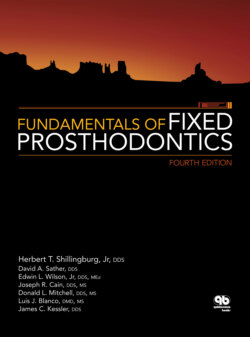Читать книгу Fundamentals of Fixed Prosthodontics - James C. Kessler - Страница 46
На сайте Литреса книга снята с продажи.
Tooth–Transverse Horizontal Axis Relationship
ОглавлениеTo achieve the highest possible degree of accuracy from an articulator, the casts mounted on it should be closing around an axis of rotation that is as close as possible to the THA (hinge) of the patient’s mandible. This axis is an important reference because it is repeatable. It is necessary to transfer the relationship of the maxillary teeth, the THA, and a third reference point from the patient’s skull to the articulating device. This is accomplished with a facebow, an instrument that records those spatial relationships and is then used for the attachment of the maxillary casts to the articulator.
The more precisely located the THA, the more accurate the transfer and the mounting of the casts will be. The most accurate way to determine the hinge axis is by the “trial and error” method developed by McCollum and Stuart in 1921.5 A device with horizontal arms extending to the region of the ears is fixed to the mandibular teeth. A grid is placed under the pin at the end of the arm, just anterior to the tragus of the ear. The mandible is manipulated so that the condyles are in the optimum position in the mandibular fossae with the articular discs properly interposed, from which it is guided to open and close 10 mm. As it does, the pin will trace an arc (Fig 3-8). The arm is adjusted in small increments to move it up, down, forward, or back, until the pin simply rotates without tracing an arc. This is the location of the hinge axis, which is marked with ink on the patient’s face.
The facebow is attached to the maxillary teeth, and the side arms are adjusted so that the pin at the free (posterior) end of each side arm will touch the hinge axis mark on its respective side of the face (Fig 3-9). A third reference point is selected on the face and recorded by adjusting a pointer on the facebow. The facebow is removed from the patient and transferred to the articulator. The reference pins on the facebow are placed over the axis of rotation on the articulator condyles. With the anterior reference device providing the vertical orientation of the facebow, it can then be used to accurately mount the maxillary cast on the articulator. This technique is most commonly used for facebow transfers to fully adjustable articulators.
A facebow that employs an approximate location of the hinge axis based on an anatomical average can also be used. This technique should provide enough accuracy for the restoration of most mouths, if the occlusal vertical dimension is not to be altered to any significant extent. An error of 5.0 mm in the location of the THA will produce a negligible antero-posterior mandibular displacement of approximately 0.2 mm when a 3.0-mm centric relation record is removed to close the articulator.4
Table 3-1 Accuracy of arbitrary hinge axis points*
Fig 3-10 Three caliper-style facebows among those in use at the present time: (a) QuickMount (Whip Mix); (b) Denar Slidematic (Whip Mix); (c) Hanau Spring-Bow (Whip Mix).
There are numerous techniques used for arbitrarily locating the hinge axis to serve as the set of posterior reference points for a facebow.6–14 A comparison of the accuracy of arbitrary and kinematically located hinge axis points is shown in Table 3-1.
Facebows must have acceptable accuracy and be simple to apply or they will not be used routinely. Caliper-style ear facebows possess a relatively high degree of accuracy, with 75% of the axes located by it falling within 6 mm of the true hinge axis.12 There are several caliper-style facebows (Fig 3-10). They are designed to be self-centering so that little time is wasted in centering the bite fork and adjusting individual side arms. The technique for their use is described in chapter 4.
Fig 3-11 An air-activated pantograph for recording mandibular movements.
Fig 3-12 Tracings are shown for a pantograph in which all recording tables are attached to the mandible and all styli are attached to the maxilla. Styli are shown in their initial positions. (a) Left lateral excursion; (b) right lateral excursion; (c) protrusive excursion.
